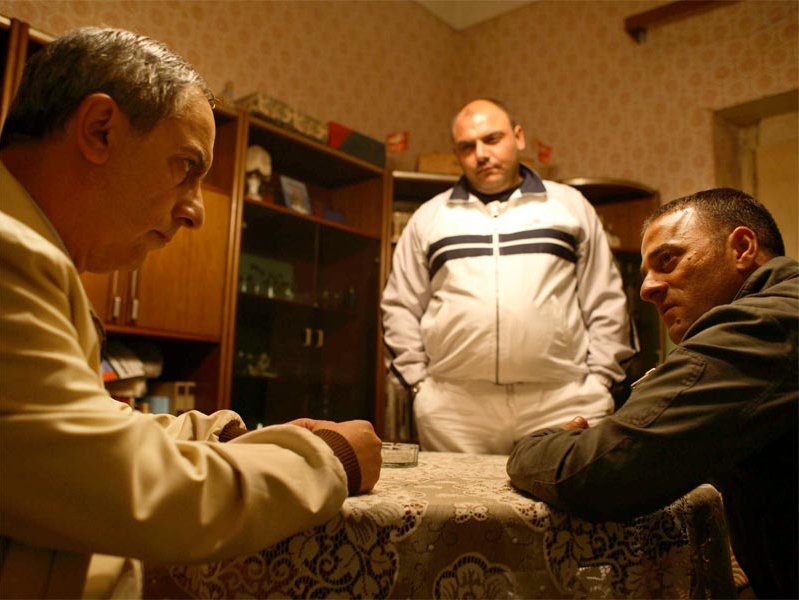As expected, the bodies pile up in Matteo Garrone's new film "Gomorrah," but luckily, the corpse-a-minute average of the first four minutes isn't maintained in the nearly two and a half hour film.
To the credit of Garrone -- director of "The Embalmer" -- "Gomorrah" isn't nearly as bloody as you might expect from a film about the Camorra, Naples' organized crime underworld. (Note: in Italian the film is called "Gomorra," a play on the word's similarity to the name Camorra.)
While there's sense of dread throughout this no-nonsense, guileless look at a cold, violent world of cash (from drugs, from illegal dumping, from other sources) and spilled blood, Garrone sometimes doesn't even show the physical impact of the bullets we hear thundering out of the soundtrack. He knows that we know already what the results look like.
"Gomorrah" is based on the book of the same name by Naples journalist Roberto Saviano, who, in the wake of the smash success of his expose, is never without police bodyguards.
"Gomorra" -- the book -- struck such a chord in Italy that even today there are more than a dozen Facebook groups in support of the writer and two of those groups alone have nearly 400,000 members. This, in a country of 55 million people.
But while Saviano's book is reportage, Garrone's film -- which the two co-wrote with Maurizio Braucci, Ugo Chiti, Gianni Di Gregorio and Massimo Gaudioso -- is fiction, with characters most certainly based on true-to-life "types."
Types like the knuckleheaded renegade young duo that thinks it can tangle with the Camorra and win, like the eager young kid from the suburban Neapolitan projects who can't help but be drawn in by the money, like the corrupt businessman destroying the countryside with his illegal toxic dumps, like the naïve money carrier who seems to think he can bow out when war starts, and like the talented tailor who is under the thumb of the mob.
There is no glorification at work here. No myth-making. Garrone is not out to create memorable characters that charm us -- like, say, Martin Scorsese -- the American director lends his name to the film as its "presenter" in the U.S. -- who created mobsters who cut garlic with razor blades in their prison cells, and Coppola, who gave us Don Corleone in his sprawling manor house.
The criminals in "Gomorrah" are not after respect and they don't follow long-proscribed, vaguely chivalric traditions of honor and family.
In one scene, a boss tells wannabe convert Don Ciro (Gianfelice Imparato), "We have to score, kill people, and we need money."
There are no luxurious backyard weddings in the Neapolitan Gomorrah. There is only blood and money.
Born in Brooklyn, N.Y., where he lived until he was 17, Bobby received his BA-Mass Communications from UWM in 1989 and has lived in Walker's Point, Bay View, Enderis Park, South Milwaukee and on the East Side.
He has published three non-fiction books in Italy – including one about an event in Milwaukee history, which was published in the U.S. in autumn 2010. Four more books, all about Milwaukee, have been published by The History Press.
With his most recent band, The Yell Leaders, Bobby released four LPs and had a songs featured in episodes of TV's "Party of Five" and "Dawson's Creek," and films in Japan, South America and the U.S. The Yell Leaders were named the best unsigned band in their region by VH-1 as part of its Rock Across America 1998 Tour. Most recently, the band contributed tracks to a UK vinyl/CD tribute to the Redskins and collaborated on a track with Italian novelist Enrico Remmert.
He's produced three installments of the "OMCD" series of local music compilations for OnMilwaukee.com and in 2007 produced a CD of Italian music and poetry.
In 2005, he was awarded the City of Asti's (Italy) Journalism Prize for his work focusing on that area. He has also won awards from the Milwaukee Press Club.
He has be heard on 88Nine Radio Milwaukee talking about his "Urban Spelunking" series of stories, in that station's most popular podcast.



